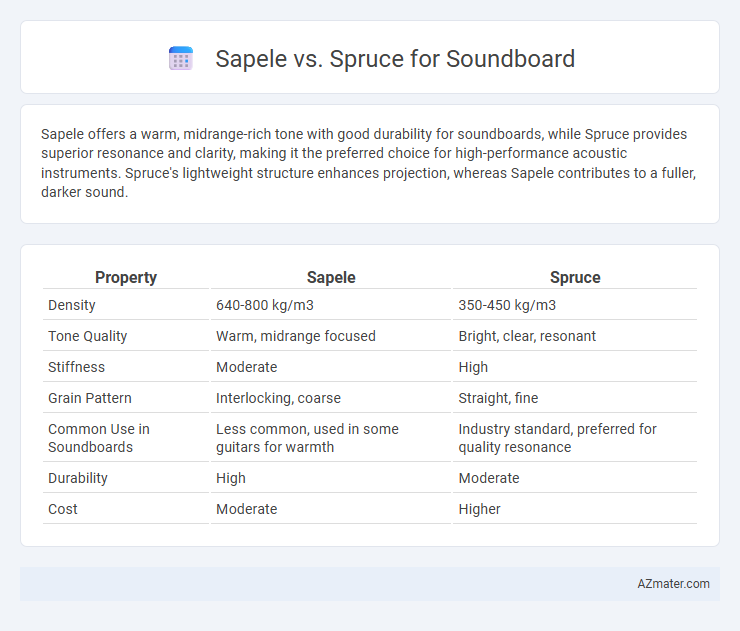Sapele offers a warm, midrange-rich tone with good durability for soundboards, while Spruce provides superior resonance and clarity, making it the preferred choice for high-performance acoustic instruments. Spruce's lightweight structure enhances projection, whereas Sapele contributes to a fuller, darker sound.
Table of Comparison
| Property | Sapele | Spruce |
|---|---|---|
| Density | 640-800 kg/m3 | 350-450 kg/m3 |
| Tone Quality | Warm, midrange focused | Bright, clear, resonant |
| Stiffness | Moderate | High |
| Grain Pattern | Interlocking, coarse | Straight, fine |
| Common Use in Soundboards | Less common, used in some guitars for warmth | Industry standard, preferred for quality resonance |
| Durability | High | Moderate |
| Cost | Moderate | Higher |
Introduction: Sapele vs Spruce Soundboards
Sapele offers a dense, hardwood grain that provides warm, rich tones with strong midrange presence, making it favored for a balanced sound in acoustic instruments. Spruce, known for its lightweight and resonant qualities, delivers bright, clear, and dynamic sound projection, establishing it as a classic choice for soundboards. Comparing Sapele to Spruce highlights a trade-off between the warm tonal richness of hardwood and the vibrant resonance of softwood.
Overview of Sapele and Spruce Wood
Sapele is a hardwood known for its rich, warm tonal qualities and natural resonance, often utilized in guitar soundboards to produce a balanced midrange with enhanced sustain. Spruce, a softwood classified mainly as Sitka or Engelmann, is prized for its clear, bright tone and strong dynamic range, providing excellent responsiveness and projection. Both woods offer distinctive acoustic properties, with Sapele delivering a richer tonal palette and Spruce emphasizing clarity and articulation in soundboards.
Physical Properties Comparison
Sapele, a dense hardwood with a Janka hardness of 1,410 lbf, offers excellent durability and stability for soundboards, contributing to a warm, balanced tone with good projection. Spruce, significantly lighter with a Janka hardness of around 510 lbf, is favored for its high strength-to-weight ratio and superior elasticity, producing bright, resonant sound and enhanced responsiveness. The higher density of Sapele results in increased sustain and warmth, while Spruce's lighter physical properties enable faster soundboard vibration and dynamic tonal clarity.
Sound Quality and Tonal Characteristics
Sapele produces a warm, balanced tone with pronounced midrange frequencies and enhanced sustain, making it a popular choice for rich, full-bodied soundboards in acoustic guitars. Spruce offers a bright, clear, and dynamic tonal profile with excellent responsiveness and strong projection, favored for its crisp attack and versatility across playing styles. Soundboards made from spruce typically emphasize clarity and articulation, while sapele enhances warmth and midrange presence, influencing the overall tonal character of stringed instruments.
Durability and Longevity
Sapele wood offers greater durability and longevity for soundboards compared to spruce due to its dense, hardwood nature that resists wear and environmental changes. Spruce, while prized for its superior acoustic properties and responsiveness, is softer and more prone to dents and damage over time. Choosing sapele enhances soundboard resilience, making it ideal for instruments subjected to frequent use or varying climates.
Visual Appeal and Aesthetic Differences
Sapele features a rich reddish-brown color with a fine, often interlocked grain pattern that adds a luxurious, warm aesthetic to soundboards, contrasting sharply with spruce's pale cream to light yellow hue and straight, uniform grain that offers a classic, clean look. The natural luster of sapele enhances visual depth and complexity, appealing to those seeking a more exotic or striking appearance in acoustic instruments. Spruce, known for its subtle elegance and brightness, maintains a traditional and timeless visual identity favored in high-performance soundboards.
Suitability for Different Music Genres
Sapele offers a warm, balanced tone with strong midrange presence, making it suitable for genres like blues, jazz, and rock where a rich, full-bodied sound is preferred. Spruce provides a bright, clear, and dynamic response with excellent projection, ideal for classical, bluegrass, and fingerstyle playing that demands crisp articulation and sustain. The choice between Sapele and Spruce soundboards depends on the desired tonal color and responsiveness tailored to specific musical styles.
Price and Availability
Sapele offers a mid-range price point and is widely available due to its sustainable harvesting in West Africa, making it an economical choice for soundboards. Spruce, particularly Sitka and Engelmann varieties, tends to command higher prices and fluctuates in availability because of growing demand and forest regulation challenges. Both woods provide quality tonal properties, but budget constraints and regional sourcing heavily influence the decision between Sapele and Spruce for soundboards.
Player Preferences and Experiences
Sapele offers a warmer, midrange-rich tone preferred by players seeking a fuller sound with enhanced low-end presence, often described as smooth and balanced, making it ideal for blues and rock genres. Spruce is favored for its bright, clear, and resonant qualities, providing superior dynamic range and projection, which appeals to fingerstyle and flatpick guitarists demanding articulation and responsiveness. Player experiences highlight Sapele's durability and aesthetic appeal, while Spruce is lauded for its versatility and classic tonal clarity in diverse playing styles.
Conclusion: Choosing the Right Soundboard Wood
Sapele offers a warm, balanced tone with strong midrange presence, making it ideal for players seeking a rich, vintage sound, while spruce provides bright, clear projection and dynamic responsiveness favored in a wide range of musical styles. The choice between sapele and spruce for a soundboard ultimately depends on the desired tonal character and playing environment, with spruce excelling in clarity and volume and sapele delivering warmth and sustain. Musicians prioritizing versatility often prefer spruce, whereas those valuing depth and a smooth tonal palette may opt for sapele soundboards.

Infographic: Sapele vs Spruce for Soundboard
 azmater.com
azmater.com